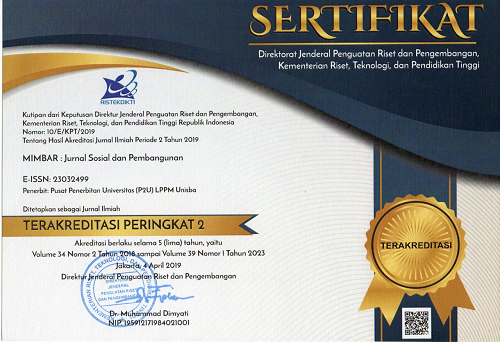Revitalisation of Vocational High School in the Business and Management in Indonesia
Abstract
Indonesian demographic premium with the profile of productive age dominated by general high school graduates negatively affects national productivity levels. As an institution that produces skilled labour, vocational high school is expected to become an institution that provides a solution to increase labour productivity. As a government strategy to overcome these problems, the Presidential Instruction No. 09 of 2016 to revitalise the vocational high school aimed at improving the competence of vocational high school graduates. This research aims to see how the revitalisation programme designed by the government is driving vocational high school majoring Business and Management in Indonesian. The study uses a mixed method with document analysis, interviews, and questionnaires. The results of this study show that 60% of vocational high school curriculum in SMKN 2 Pariaman has met the requirements of the industry, while 40% has not. Since the industry is not yet involved in the preparation of the vocational high school curriculum, then the revitalisation programme has not fully impacted vocational high schools in Indonesia.
Keywords
Full Text:
PDFReferences
Adam, Sampun., & Rahayu, Nastiti (2017). Strategi Implementasi Revitalisai SMK. Direktorat Pembinaan Sekolah Menengah Kejuruan.
Dewi, I. G. K. (2015). Analisis Pelaksanaan Kerjasama SMK dengan Dunia Usaha. Jurnal Pendidikan Bisnis Dan Manajemen, 1(1), 1–70.
Disas, E. P. (2018). Link and Match sebagai Kebijakan Pendidikan Kejuruan. Jurnal Penelitian Pendidikan, 18(2), 231–242. https://doi.org/10.17509/jpp.v18i2.12965
Djoeffan, Sri Hidayati. (2004). Revitalisasi Pendidikan sebagai Paradigma Peningkatan Kualitas Bangsa. Mimbar, 20(2), 219–233.
Kemendikbud. (2018). Peraturan Direktur Jenderal Pendidikan Dasar Dan Menengah Kementerian Pendidikan Dan Kebudayaan Nomor: 07/D.D5/Kk/2018 Tentang Struktur Kurikulum Sekolah Menengah Kejuruan (Smk)/ Madrasah Aliyah Kejuruan (Mak). Kemendikbud, 021, 307. http://psmk.kemdikbud.go.id/konten/3824/struktur-kurikulum-smk-perdirjen-dikdasmen-no-07dd5kk2018-tanggal-7-juni-2018
Mattulada, H. . (2000). Revitalization and Reactualization of Local Culture to Strengthen National Unity). Revitalisasi dan Reaktualisasi Budaya Lokal untuk Memperkokoh Kesatuan Nasional. Makalah disajikan dalam seminar di Bandung 5,6,7 Agustus 2000.
Pemerintah Republik Indonesia. (1990). Peraturan Pemerintah Republik Indonesia Nomor 29 Tahun 1990.
Pemerintah Republik Indonesia. (2013). : Undang-Undang Nomor Undang-Undang Nomor 20 Tahun 2003.
Pemerintah Republik Indonesia. (2016). Instruksi Presiden Nomor 9 Tahun 2016 tentang Revitalisasi SMK dalam rangka Peningkatan Kualitas dan Daya Saing SDM Indonesia (pp. 1–10). https://kemdikbud.go.id/main/files/download/e451d9ec3a04121
Roberts, P., & Sykes, H. (2000). A Handbook 12 Lessons from America in the 1990s.
Schoenfeld, A. (1998). Toward a theory of teaching-in-context. Issues in Education, 4(1), 1–94. https://doi.org/10.1016/s1080-9724(99)80076-7
Soemanto, H. S. dan W. (1986). Pembinaan dan Pengembangan Kurikulum :Sebagai substansi Problem Administrasi Pendidikan. Bina Aksara.
Sutiyoso (2005). Gubernur Provinsi Daerah Khusus Ibukota Jakarta. 7, 583–606.
Tsuchiya, K. (2018). APO Productivitity Databook 2018. In Tsuchiya, Koh.
DOI: https://doi.org/10.29313/mimbar.v37i1.8033
Refbacks
- There are currently no refbacks.
MIMBAR : Jurnal Sosial dan Pembangunan is licensed under Creative Commons Attribution-NonCommercial-ShareAlike 4.0 International License.















